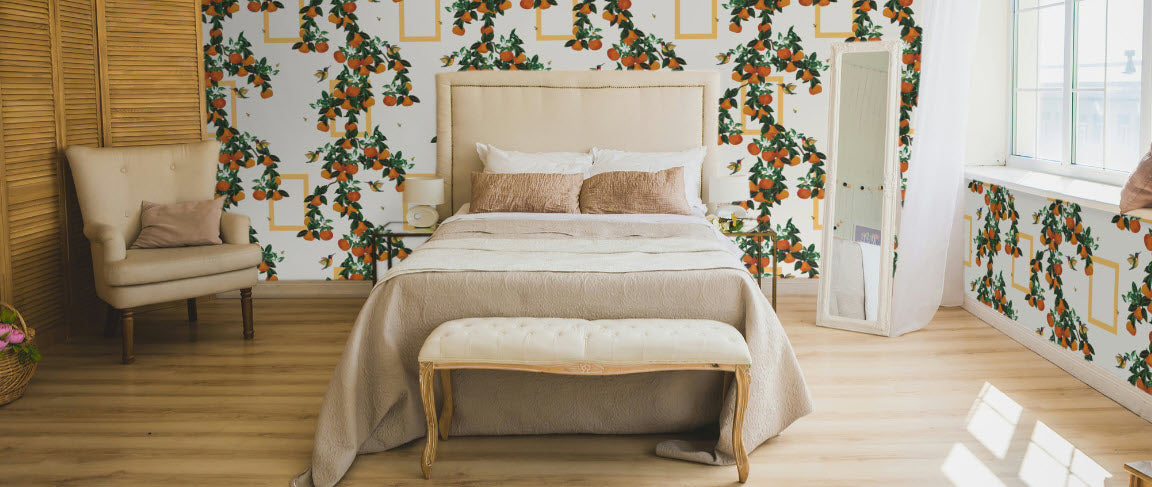Originally published by Marni Jameson, reprinted with permission.

“Wallpaper?”
“Yes. Wallpaper,” the designer said.
“I haven’t put wallpaper in a home in 15 years.”
“Where have you been? Wallpaper is huge.”
Then I started noticing. He was right.
A couple months ago, I got the bug to refresh and update my dining room. I was not being rash. The furniture dates back to the 1990s. You know, before women could vote. So, I asked Los Angeles designer Christopher Grubb, whom I’ve known for years, to provide consultation. That is, I would send him photos. He would provide decorating direction. I would do the legwork. This arrangement saved us both hours of indigestion.
Technically, an alcove not a room, as it only has two walls, the dining room is located directly off the entryway. Because it’s the first room you see when you come in the front door, I want it to shine. Grubb gave me a to-do list: add a pair of long mirrors, put black lampshades on the chandelier, get new chairs (but keep the table), and wallpaper the back feature wall and the ceiling with a rich, medium-blue grasscloth to distinguish the dining area from the entry.
I requested six wallpaper samples, lived with them for a few days, chose one, and ordered eight rolls. I then hired my handyman to prepare the wall and ceiling, which meant filling in the textured surfaces to make them smooth as baby skin.
“Wallpaper is really hot now,” my handyman told me as he got to work. “I’m floating walls in homes once a week. Not long ago, I could go for months without a request.”
Wallpaper installer Catie Skelton, who with her brother Tim Skelton, runs Element Wallcoverings, of Orlando, said, “Wallpaper used to be just for high-end homes. But now, thanks to social media and more brand competition, it’s accessible to the middle class. Plus, customers are realizing that wallpaper doesn’t have to have little flowers and strawberries. You can choose from thousands of bold patterns, textures, and contemporary prints.”

Indeed. Even my daughter and her husband, on-trend millennials, recently hung wallpaper on the feature wall of the nursery they are preparing for their baby due next month(!).
“We looked at a lot of inspiration photos,” my daughter said. “Almost all the nurseries had accent walls either painted a fun color or wallpapered. The rooms we liked best all had wallpaper.” They chose a peel-and-stick paper featuring soft illustrations of woodland creatures, which my son-in-law put up himself.
Though more expensive than paint and more work, done right, adding wallpaper to a room adds richness and interest that paint alone simply can’t. “Updating a room with a paint color is an easy change,” Grubb said, “but if you truly want to elevate a room, wallcovering is the way to go.”
Sold.
The wallpaper went up this weekend. It’s a lovely improvement. So now that I am up with the times, I asked Grubb and the Skeltons to tell me more about the wallpaper comeback, and what more homeowners should know:
Be unexpected. Wallpaper isn’t just for living rooms and powder baths. “I like using wallpaper in secondary rooms, too,” Grubb said. For one Los Angeles couple who enter their house through the laundry room, Grubb covered the laundry room walls with a lively graphic paper. “It completely changed the feeling of this utility space and puts a smile on the owners’ faces whenever they come home.”
Go big. Many people are afraid of large-scale patterns, especially in small spaces, but a large pattern can add excitement whether on one feature wall or all walls. “I especially like using it in a powder room,” Grubb said.
Float don’t line. Because so many homes have textured walls, such as knock down or orange peel surfaces, which prevent wallpaper from being smooth, Tim Skelton recommends “floating” the walls, skim coat them with drywall mud to fill in the recesses. Some people hang a wallpaper liner, which is almost twice the work, he said, “but the bumps still show through. Floating is the way to go.”
Don’t skimp on installation. If your paper has a tricky repeat that needs special alignment or your room has lots of angles, hire a pro to install it, Grubb said. “I've had clients try to save money by hiring someone inexperienced or by doing the job themselves and they ran into alignment issues that got more attention than the beauty of the material.” Get more than one bid. Costs can vary widely.
Consider the new vinyl. Today’s vinyl wallpaper often looks like grasscloth or silk, but is a lot less fragile and more durable, Grubb said. “It's easy to maintain and clean with soap and water.”
Enjoy the sound effects. While all wallpaper will dampen outside noise a bit, fabric wallcoverings made of linen, silk or cotton, as well as grasscloth, are especially good at buffering sounds so are good choices for home offices and bedrooms.
Why the ceiling? Wallpaper on a ceiling can provide an immersive effect that feels intimate. By applying the same grasscloth to both the wall and ceiling in my dining area, we carried the color through the space, making the room feel cozier.
What’s new? Custom murals are hot, Tim Skelton said. “Companies now will print on vinyl any high-resolution image to create a mural. He’s installed Disney-themed murals, 360-degree murals that make you feel as if you’re inside a mangrove forest, and, for one gentleman’s garage, a mural featuring race cars on a Formula One racetrack.
Removables are rising.Peel-and-stick wallpapers have also evolved and offer homeowners a less-expensive DIY option that is easy to change and won’t messing up the wall. This is especially good for renters. The downside of peel-and-stick papers is that most professional installers won’t put them up because they can’t guarantee the product will stay.




